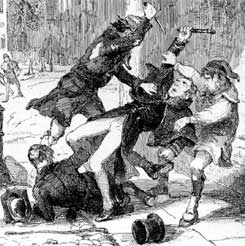 Almost every street has a gruesome story to tell Almost every street has a gruesome story to tell
Numerous filthy murders committed in north London during the last four centuries have gone undetected. Dan Carrier investigates
Foul Deeds and Suspicious Deaths in Hampstead, Holborn and St Pancras by Mark Aston
Wharncliffe Books, £10.99
Nothing captures the imagination better than a gruesome murder, and this book has 405 years of violent crime between its covers.
Based on macabre tales of horrific events in the old boroughs of St Pancras, Hampstead and Holborn, it will satisfy those with a taste for the grisly.
Written by Mark Aston, a librarian at the Holborn Studies Archive, Foul Deeds and Suspicious Deaths is not just interesting because of the ghoulish nature of its subject matter. It seems there is hardly a road in Camden that has not seen a brutal crime.
“When I started researching the book, so many people had heard of the stories,” says Mr Aston. “They have entered common folklore and this shows how our imaginations are fired by such ghoulish tales.
“For every murder I write about, I found 50 others.
“I looked for things that were unusual,” he said.
One such story is the tale of Mother Red Cap.
As Mr Aston relates: “Even the mere mention of her name instilled fear into the minds of the then rural Kentish Town.”
Her fame was such that songs and poems were written in her honour – but forgetting the legends, Mr Aston has discovered Red Cap’s real story.
“She was born in the 17th century,” he says. “Her father, Jacob Bingham, married a peddlar’s daughter and they named their child Jinney.”
Jinney was to become the infamous Mother Red Cap – dubbed so because of her choice in hats.
of her choice in hats. “She had a baby when she was 16 and the father was known as ‘Gypsy George’. Jacob built them a cottage on wasteland near Kentish Town but, shortly after, tragedy occurred.”
George was convicted of stealing sheep in Holloway and hanged at Tyburn.
“A violent, hard drinking man called Darby replaced George as her next love but his brutal treatment towards her left her to seek help from her mother,” says Mr Aston.
“The problem was solved: he disappeared.”
Rumours were rife that something underhand had occurred.
Then fate dealt Jinney a further blow: her parents were accused of witchcraft and hung.
“Poor Jinney found comfort in the arms of her next lover, a man by the name of Pitcher, who moved into the cottage,” explains Mr Aston.
“Third time lucky in love for Jinney? Sadly not. Pitcher’s remains were later discovered in Jinney’s oven. By now, Jinney had developed a wicked temper but she was acquitted of his murder.A neighbour testified that Pitcher ‘often got into the oven to hide himself from her tongue’, suggesting the death could have been accidental.”
Her reputation spread and she became a recluse, coming out only at night to scavenge for food.Then when a rich lodger died, it seemed to confirm people’s fears. Locals blamed calamities on her and she became known as a witch.
Mr Aston also sheds light on the Dr Crippen case, which is famous because Dr Crippen was caught escaping to Canada with his lover after the sea captain on his ship recognised him and sent a radio message to the police. It was the first time the device had been used in this way.
But Mr Aston says evidence came to light that the body of Mrs Crippen, discovered in the basement of their house in Tufnell Park, was actually someone else’s.
“After the case, a series of letters written in the hand of the murdered wife were sent to Winston Churchill, the then home secretary, saying she was living in California,” reveals Mr Aston. “They were never properly investigated.”
But one crime that was solved because of the doggedness of the St Pancras coroner was the supposed murder of Samuel Furnace, which became known as the ‘burning shed mystery’.
In 1933 the charred remains of Mr Furnace, a builder, were found in a shed in Hawley Crescent next to what is now the MTV studios.
At first it seemed he had committed suicide: he was in debt and had left a note for his family. But then the coroner William Purchase decided to look at the corpse. The teeth had not been harmed by the fire, and there were still scraps of clothing undamaged. Mr Purchase studied the remains of the head – and discovered a bullet wound.
A post-mortem then revealed that the teeth were of a younger person than Furnace – prompting a massive man hunt. And the police got a lucky break because of the murderer’s ineptitude: the corpse had a post office savings book in his pocket, belonging to a Walter Spratchett of Dartmouth Park Road.
A dentist identified Walter’s teeth and his father confirmed the body was his son.
“Police discovered the pair were acquainted – they worked for a housing agent and would play billiards together.
“The day before the fire, Spratchett had collected £36 in rent payments for his boss but failed to return to his office. He had disappeared.”
Furnace was caught when he wrote to his brother-in-law and asked him to bring clothes and a passport to Southend station.
Police tailed him to the rendezvous – where the murderer was waiting.
“There was one final twist,” says Mr Aston. “Furnace while being held in a cell, asked for his overcoat to keep him warm.” In the lining of the coat was a bottle of hydrochloric acid – which Purchase swigged leading to an agonising death.
A free illustrated exhibition based on the book is at Holborn Library, 32 Theobalds Road,WC1, until January 14. 020 7974 |

